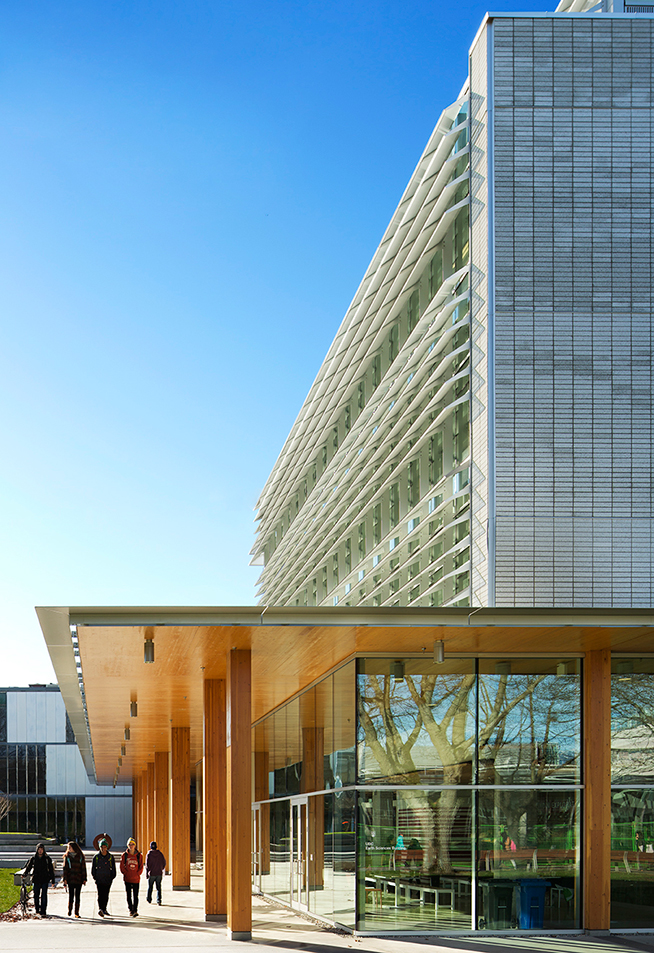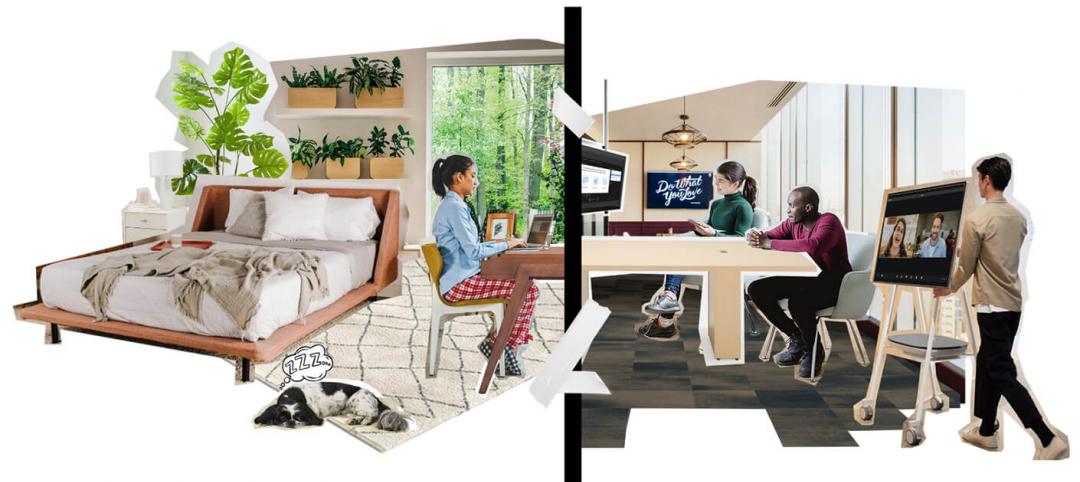As designers, we are custodians of the built environment. With the pressure to reduce the carbon footprint of buildings, it is our responsibility to carefully consider the environmental impact of our work, balanced with the functionality and cost considerations of every project.
As a firm dedicated to innovation and advancement of sustainable design, Perkins+Will has been a strong advocate for the use of wood in buildings for the many benefits it affords. Wood is the only building material that is made by the sun, completely renewable, and able to absorb and sequester carbon throughout its lifetime. In addition, wood is a healthy material choice; it creates a special quality of space, contributing to a feeling of warmth and well-being and supporting exceptional building performance.
While timber used as structure is certainly not unusual in low-rise construction, it has been largely abandoned as a structural solution in taller buildings over the last century, in favor of heavier and more intense materials, concrete and steel.
Now, with the relatively recent advent of engineered, mass timber products, such as cross laminated timber (CLT) and laminated veneer lumber (LVL), buildings can now safely reach heights beyond four levels with lower environmental impact.
The Perkins+Will building portfolio has always prominently featured wood. Recently, we completed the Earth Sciences Building (ESB) on the University of British Columbia’s Vancouver campus in which we used engineered mass timber products for structure on the five-story academic wing, demonstrating the potential for building higher with wood. As one of only three examples of modern, taller wood construction in North America, the ESB project has become an important example of the potential of mass timber products in major construction projects in our market, and it is now part of a small group of relatively recently built projects around the world that have successfully completed taller wood buildings.
Last October, on the heels of the Earth Sciences Building, we were awarded the opportunity to conduct a survey among leading stakeholders around the world to gather lessons learned and to document experiences in building tall wood projects. Forestry Innovation Investment and the Binational Softwood Lumber Council engaged our research team to visit built projects and to speak directly to building owners, designers, builders, and authorities having jurisdiction.
The goal of the work was to gather information from the market leaders to learn from their applied experience to help reduce risk and accelerate adoption of tall wood buildings. It was an extraordinary opportunity. We traveled through Europe to visit the projects and speak with designers, constructors, timber fabricators, developers, and authorities about their experiences. Not only did we benefit from their wealth and depth of knowledge, but we were able to view the buildings, experience the spaces, and understand the context of the projects first hand.
In addition, we have now established contacts and relationships with many of the stakeholders, which has proven to be an invaluable result of the work as we continue to expand our knowledge and practice.
The result of this work is documented as the Survey of International Tall Wood Buildings, which includes a series of bulletins for each participant project, detailing lessons learned in the context of each stakeholder group. Each of these bulletins formed the basis of the Summary Report where the information is aggregated and interpreted at a broader level to identify trends across projects, unique solutions and, of course, lessons learned.
While there have been several important technical resources published recently to support tall wood building, this work is key to filling a gap in the literature: it is the first time lessons have been gathered among the majority of built examples, and have been cross-referenced and aggregated to identify trends and common themes. While the results are not surprising, it solidifies and gives additional credibility to the efforts of advancing the market for tall wood buildings.
Explore the report to learn why these successful projects chose to pursue a wood solution, the best practices and lessons learned for designing, constructing, and navigating the approvals process, as well as the issues to consider with respect to insurance and financing tall wood projects. The report concludes with a section on building performance, demonstrating the important link between low carbon and low embodied energy materials, healthy indoor environments, and energy efficiency in operation.
This important work was possible only because more than 50 participants generously responded to our survey, hosted us at their buildings, spent hours touring and answering questions, and shared technical documents and images of their work. We truly appreciate their willingness to share their experience and time with us.
About the Author
Rebecca Holt is a Senior Sustainable Building Advisor and researcher with Perkins+Will’s Research team. She has been consulting on a variety of work related to sustainability concepts and high performance building design for more than 12 years. She contributes to community energy plans, sustainability plans and policy, green building strategies, indicator and benchmarking programs, and sustainable land use plans. Holt was the lead researcher and primary author of the Survey of International Tall Wood Buildings. She can be reached at: rebecca.holt@perkinswill.com.
Read more posts from Perkins+Will's Ideas + Buildings blog
More from Author
Perkins and Will | Sep 19, 2023
Transforming shopping malls into 21st century neighborhoods
As we reimagine the antiquated shopping mall, Marc Asnis, AICP, Associate, Perkins&Will, details four first steps to consider.
Perkins and Will | Jul 20, 2023
The co-worker as the new office amenity
Incentivizing, rather than mandating the return to the office, is the key to bringing back happy employees that want to work from the office. Spaces that are designed and curated for human-centric experiences will attract employees back into the workplace, and in turn, make office buildings thrive once again. Perkins&Will’s Wyatt Frantom offers a macro to micro view of the office market and the impact of employees on the future of work.
Perkins and Will | May 30, 2023
How design supports a more holistic approach to training
For today’s college athletes, training is no longer about cramming team practices and weight lifting sessions in between classes.
Perkins and Will | Dec 20, 2022
4 triage design innovations for shorter wait times
Perkins and Will shares a nurse's insights on triage design, and how to help emergency departments make the most of their resources.
Perkins and Will | Aug 30, 2021
The great re-shuffle & re-think
In this new hybrid environment in which we cater to how our employees work best, how will we manage new hybrid work practices and etiquette?
Perkins and Will | May 18, 2020
Global design firms collaborate on new COVID-19 mobile testing lab to bring testing to vulnerable communities worldwide
Perkins and Will, Schmidt Hammer Lassen Architects, and Arup Group develop scalable solutions for increased testing capacity within high-density and under-served neighborhoods.
Perkins and Will | Jun 7, 2019
Workplace wellness: Top 3 tips for Fitwel certification
How can thoughtful design encourage healthier choices, lifestyles, and work environments?
Perkins and Will | Feb 27, 2019
ResilientSEE: A framework to achieve resilience across scales
Conceived in the Boston studio of Perkins+Will, the ResilientSEE team developed a resilient planning framework that can be applied to other neighborhoods, cities, and countries.
Perkins and Will | Nov 28, 2018
Amazon HQ2 and the new geography of work
The big HQ2 takeaway is how geography and mobility are becoming major workplace drivers.
Perkins and Will | Sep 4, 2018
It takes more than money to fund resilience
Resilient design, much like all projects in the built environment, requires funding.
















